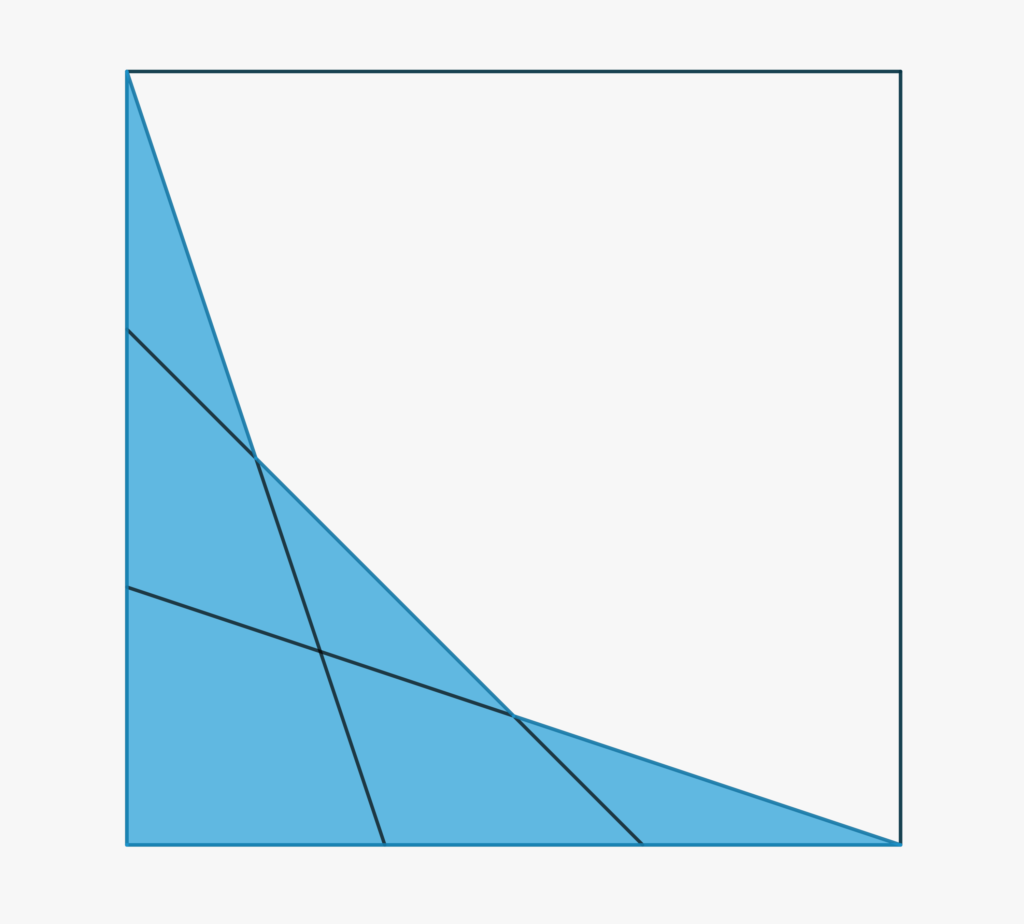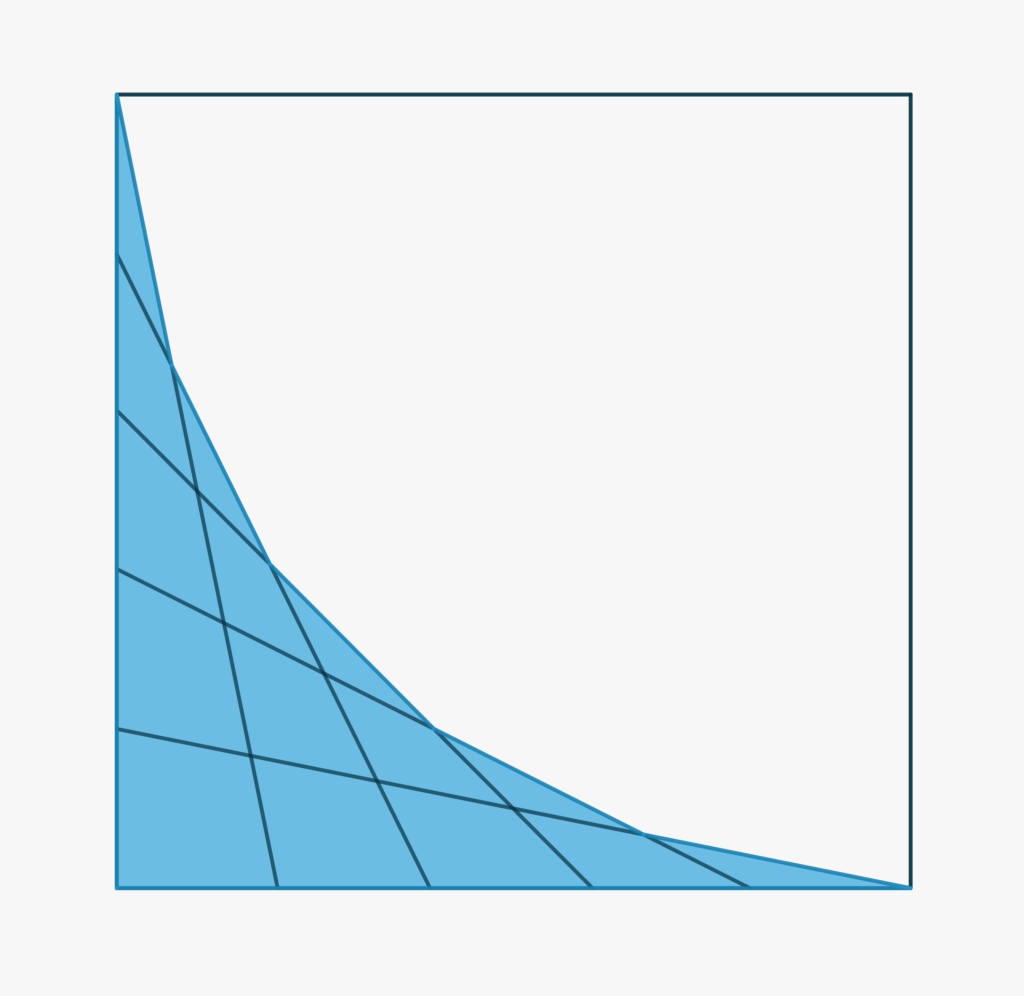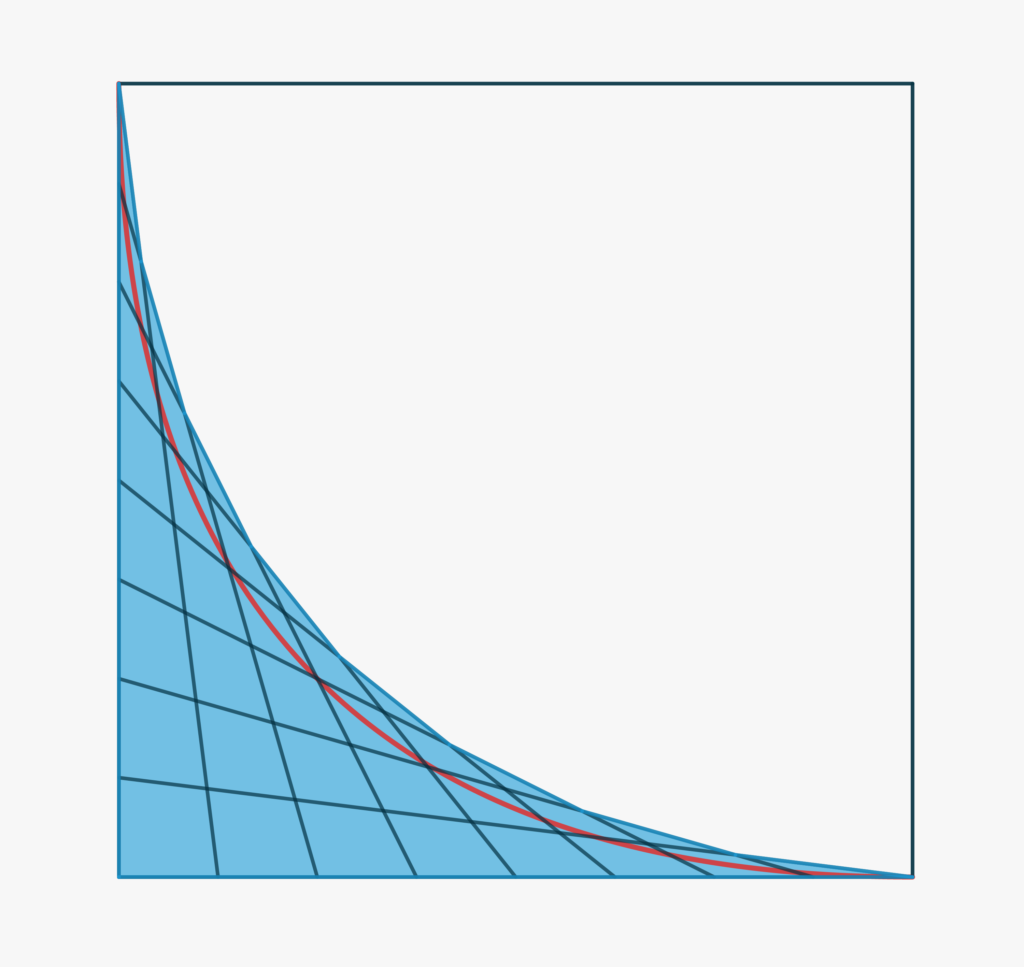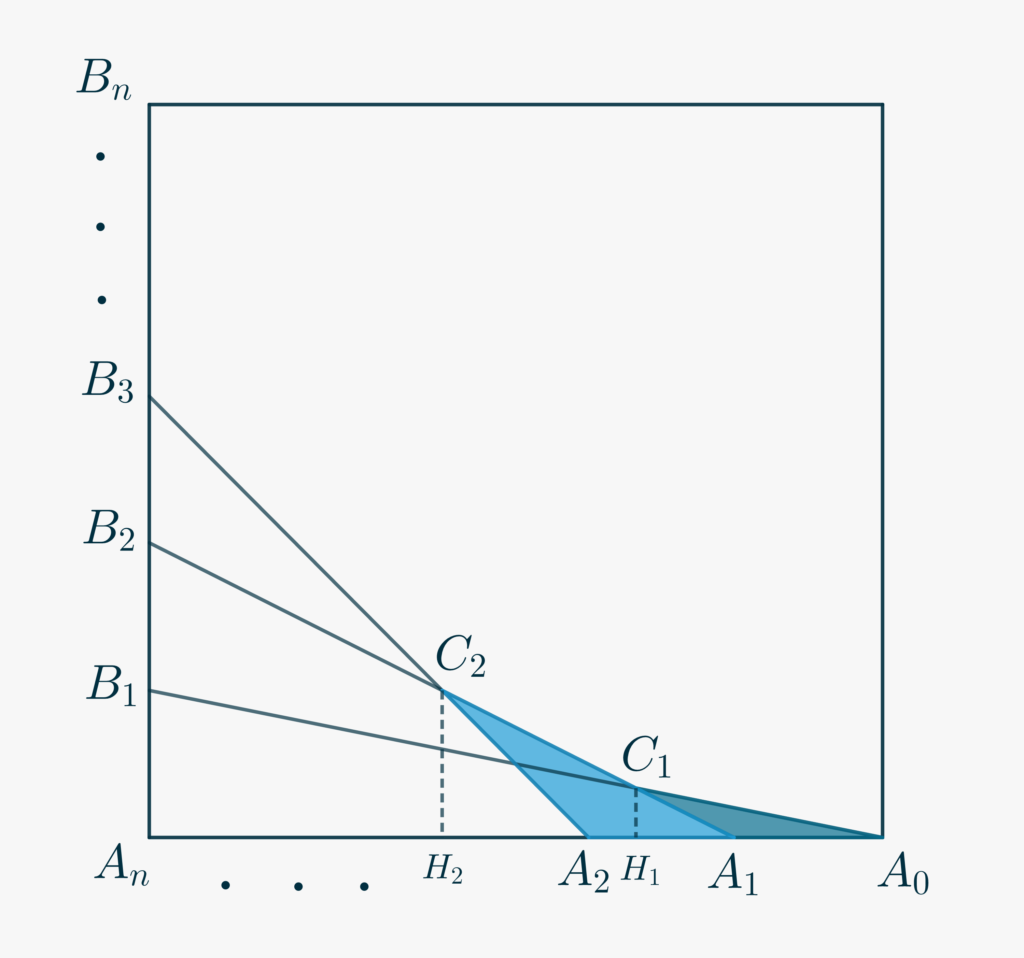We show another application of Menalaus’s Theorem, that, together with some infinitesimal calculus, will yield an unexpectedly simple result.
Consider a square of side \(1\) and divide the left and bottom sides into \(n\) segments of equal length. Connect then their end points as shown in the Figures below, for \(n=3, 5, 8\). We want to know what is the shaded area, as a function of \(n\), and in particular when \(n\to\infty\) (red line in the bottom Figure). As a final step, we also want to determine the function whose graph is represented by that red line.



We could approach the problem using coordinate geometry, but it will be instructive to use again basic theorems of Euclidean geometry.
To this purpose, let us label the main points of the square as represented below, for a generic value of \(n\). We aim at determining the required area by adding the area of triangles \(\triangle A_iA_{i-1}C_i\). Two of them are dashed below as an example.

- Note that the above mentioned triangles have all base equal to \(\frac1{n}\). We therefore only need to compute the altitude \(\overline{C_iH_i}\).
- At this aim, for \(i=1,2,\dots,n-1\), consider the triangle \(\triangle A_nA_{i-1}B_i\) cut by the line \(\overline{A_iB_{i+1}}\). Apply Menelaus’s Theorem to find \[\frac{\overline{A_{i-1}C_i}}{\overline{C_iB_i}}=\frac{i+1}{n-i}.\]
- Use the similarity \(\triangle A_nA_{i-1}B_i \sim \triangle H_iA_{i-1}C_i\) to determine \[\overline{C_iH_i} = \frac{i(i+1)}{n(n+1)}.\tag{1}\label{eq2739:1}\]
- Observe that equation \eqref{eq2739:1} is valid also for the leftmost triangle, whose altitude is equal to \(1\).
- Conclude that the shaded area is equal to \[\mathcal A(n)=\frac1{2n^2(n+1)}\sum_{i=1}^n i(i+1).\]
- Use the known results \(\sum_{i=1}^n i = \frac{n(n+1)}2\) and \(\sum_{i=1}^n i^2 = \frac{(2n+1)n(n+1)}6\) to determine the following expression, \[\mathcal A(n) = \frac{n+2}{6n},\] so that the shaded area tends to \(\frac16\) when \(n\to\infty\).
We now introduce cartesian coordinates with the origin set in \(O\equiv A_n\).
Consider the piecewise linear function whose graph is obtained by connecting the points \(B_n\equiv C_n, C_{n-1},\dots,C_2,C_1,C_0\equiv A_0\) in the Figure above. We will call \(f_n(x)\) this function.
Our purpose is that of finding the analytical expression of \(f(x)\), defined as
\[f(x) = \lim_{n\to\infty} f_n(x).\tag{2}\label{eq2739:2}\]
- For \(n=1,2,\dots,n\), call \(x_i\) and \(y_i\) abscissae and ordinates, respectively, of the point \(M_i\), midpoint of the segment \(C_{i-1}C_i\).
- Use equation \eqref{eq2739:1} and the symmetry of the graph to calculate \[x_i = \frac{i^2}{n(n+1)}\] and \[y_i = \frac{(n-i)^2}{n(n+1)}.\]
- Write \(y_i\) in terms of \(x_i\). You will get \begin{eqnarray}y_i &=& \left(\frac{n}{\sqrt{n(n+1)}}-\sqrt{x_i}\right)^2.\end{eqnarray} When \(n\to\infty\) the above expression tends to \[f(x) = \left(1-\sqrt x\right)^2.\]
- Verify that \[\mathcal A_{\infty} = \int_0^1 f(x) dx = \frac16.\]
We want to show more formally the convergence \eqref{eq2739:2}, and that the convergence is also uniform. Fix \(\varepsilon>0\).
- Using previous results, show that \begin{eqnarray}|f_n(x_i) -f(x_i)|&\leq& \left| \frac{n^2}{n(n+1)}-1+\right.\\&+&\left. 2\left(1-\frac{n}{\sqrt{n(n+1)}}\right) \right|\underset{n\to\infty}{\to} 0.\end{eqnarray}Choose \(N_1\) so that the above quantity is less then \(\frac{\varepsilon}3\), for all \(n> N_1\).
- Given a point with coordinates \((x,f_n(x))\), lying between, say, \(C_{i-1}\) and \(C_i\), show that \begin{eqnarray}|f_n(x_i)-f_n(x)| &\leq& \overline{C_nC_{n-1}} =\\&=& \frac{2n}{n(n+1)}\underset{n\to\infty}{\to} 0.\end{eqnarray}Choose \(N_2\) so that the above quantity is less then \(\frac{\varepsilon}3\), for all \(n> N_2\).
- \(f(x)\) is uniformly continuous in \([0,1]\) (why?), so that we can guarantee \[|f(x_i) – f(x)| < \frac{\varepsilon}3,\] provided that \[|x_i-x| < \delta,\tag{3}\label{eq2739:3}\] for some \(\delta\) independently of \(x\). Note that \[|x_i-x| \leq \overline{C_1A_n} = \frac{2n}{n(n+1)}\underset{n\to\infty}{\to} 0,\]so that \eqref{eq2739:3} is satisfied for sufficiently high \(n\), say \(n> N_3\).
- Using triangular inequality, show that \begin{eqnarray}|f_n(x) -f(x)| &\leq& |f_n(x)-f_n(x_i)| + \\&+&|f_n(x_i) – f(x_i)| +\\&+& |f(x_i) – f(x)|< \varepsilon\end{eqnarray} for all \(n>\max(N_1,N_2,N_3)\), for all \(x\in [0,1]\), and conclude that the sequence \((f_n(x))\) converges to \(f(x)\) uniformly.
